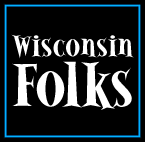Decorated Birch Bark Baskets
Wittenberg, WI
Vocabulary
Awl: A pointed tool for making holes.
Birchbark: Thin, easily peeling bark from a birch tree.
Canuck: A nickname for a person from Canada.
Ceremonial: Having to do with a ceremony or a special formal occasion.
Denomination: An organized religious group.
Embroidery: (sounds like, m-BROY-der-ee) Decoration made with stitches.
Forbears: Ancestors.
Geometric: Made with simple shapes like straight lines, circles or
squares.
Heritage: Traditions passed down from earlier generations.
Lining: A material used to cover the inner surface of something.
Master: Very skilled practitioner, excellent artist.
Motif: (sounds like, moe-TEEF) design, theme, idea.
Ojibwes: Native Americans who live in southern Canada and northern U.S.
around the Great Lakes. Their name for themselves is Anishinaabe.
Practical: Capable of being used.
Previously: Before.
Road kill: The body of a dead animal left on the road after it has been
hit by a car.
Seminar: A small class.
Thimble: A small cap worn on a finger to protect it from the needle while
sewing.
Trillium: A spring blooming flower of the lily family which has three
petals and leaves.
Upper Peninsula: The northern part of Michigan, between Lake Superior and
Lake Michigan on Wisconsin’s northeast border.
back to top
Journal Questions
 What
are the nicknames for the place where you’re from? Do the people from your town
or region have any nicknames for themselves? Where did the nicknames
originate? What
are the nicknames for the place where you’re from? Do the people from your town
or region have any nicknames for themselves? Where did the nicknames
originate?
 Have
you ever seen a trillium? What other spring wildflowers grow near your home? Have
you ever seen a trillium? What other spring wildflowers grow near your home?
 Can
a beautiful object be useful too? If you think so, describe something that fits
such a description. How is the object used and how it is beautiful? Can
a beautiful object be useful too? If you think so, describe something that fits
such a description. How is the object used and how it is beautiful?
 Have
you ever used natural materials from near your home to make something artistic
or useful? Have
you ever used natural materials from near your home to make something artistic
or useful?
 Describe
an object in your home that is both artistic and practical. Describe
an object in your home that is both artistic and practical.
back to top
Resources For Teachers
 As
you explore this topic further, be aware of regional differences in style and
technique. Plains tribes have a completely different process of quilling that
involves slitting open the quill tube, flattening and plaiting it. Ojibwe
technique uses the quill as a tubular whole, the same as Micmak and other
Woodland tribes. As
you explore this topic further, be aware of regional differences in style and
technique. Plains tribes have a completely different process of quilling that
involves slitting open the quill tube, flattening and plaiting it. Ojibwe
technique uses the quill as a tubular whole, the same as Micmak and other
Woodland tribes.
 Find
out more about Manitoulin
Island, the largest fresh water island in the world. Find
out more about Manitoulin
Island, the largest fresh water island in the world.
 Porcupine
Quillwork and Hair is an extensive site from “NativeTech: Native American
Technology and Art.” It includes a section specifically on Porcupine
Quill Decoration on Birch Bark. Porcupine
Quillwork and Hair is an extensive site from “NativeTech: Native American
Technology and Art.” It includes a section specifically on Porcupine
Quill Decoration on Birch Bark.
back to top
Resources For Students
 There’s
lots to know about birch bark baskets. Visit the Washington State University’s
Museum of Anthropology to see the
Baskets
of Birch Bark exhibit. There’s
lots to know about birch bark baskets. Visit the Washington State University’s
Museum of Anthropology to see the
Baskets
of Birch Bark exhibit.
 Christine
uses certain embroidery-like patterns when she sews quills onto birchbark. This
page, Techniques
and Patterns to Attach Quills to Birch Bark, describes seven of those
patterns. Christine
uses certain embroidery-like patterns when she sews quills onto birchbark. This
page, Techniques
and Patterns to Attach Quills to Birch Bark, describes seven of those
patterns.
 Christine
gets most of the porcupine quills she uses from roadkill. But there are other
ways to gather quills from a porcupine too. Plus, you use quills from
different parts of the body for different purposes. Read about these and other
points at Porcupine
Quill Baskets. Christine
gets most of the porcupine quills she uses from roadkill. But there are other
ways to gather quills from a porcupine too. Plus, you use quills from
different parts of the body for different purposes. Read about these and other
points at Porcupine
Quill Baskets.
 Another
traditional way of decorating birchbark is by biting patterns into it. Find out
about this at Birch
Bark Biting. Another
traditional way of decorating birchbark is by biting patterns into it. Find out
about this at Birch
Bark Biting.
 Here
is a Lakota story about porcupine quillwork and The
End of the World. Here
is a Lakota story about porcupine quillwork and The
End of the World.
 Wisconsin’s
Prickly Rodent will tell you lots about porcupines in Wisconsin. So will The
Porcupine, an article written especially for kids. Wisconsin’s
Prickly Rodent will tell you lots about porcupines in Wisconsin. So will The
Porcupine, an article written especially for kids.
 Read
Paper
Birch to find out more about these great trees in Wisconsin. Read
Paper
Birch to find out more about these great trees in Wisconsin.
back to top
Credits
Text written by Rick March, edited by Jamie Yuenger and Anne Pryor.
Sources consulted include a tape recorded interview with Christine Okerlund
by Carrie Kline (7/2/98), with the tape housed at the Wisconsin Arts Board.
Video footage from Wisconsin Folks, 1998, produced by Dave Erickson for
Wisconsin Arts Board and Wisconsin Public Television.
back to top
 |


